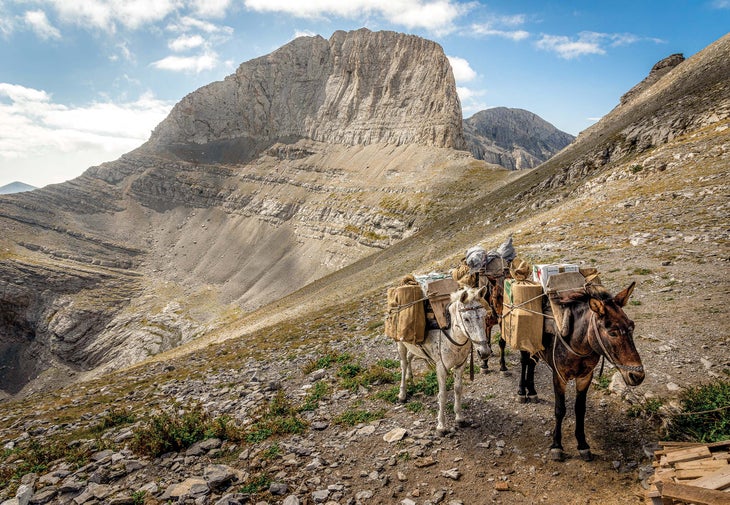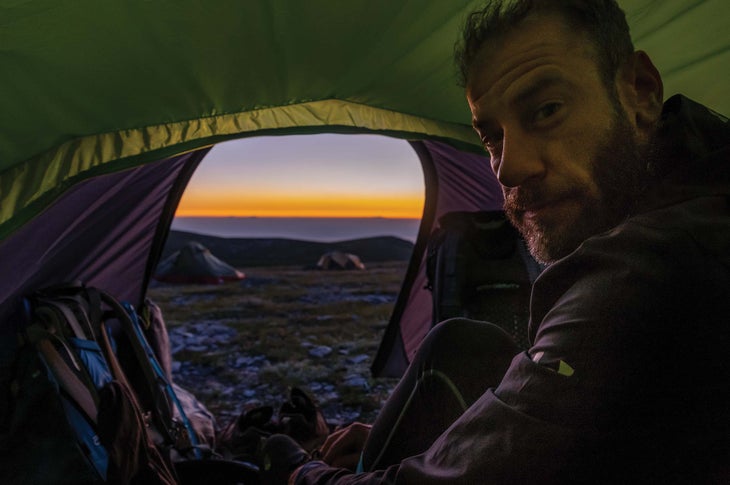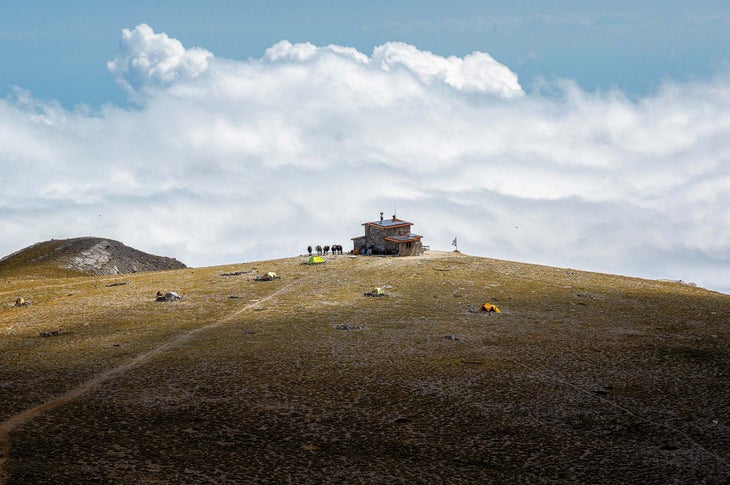Products You May Like
I felt incredibly grateful—and lucky—to have shelter when Cyclone Ianos arrived unexpectedly with the dawn on my third day in the mountains of Greece, effectively pinning down everyone in the hut until it blew itself out twenty hours later. Outside the water-stained windows of Giosos Apostolidis, the highest mountain shelter in Greece, a thick gray haze obscured the cliff-hung views of Stefani, Mt. Olympus’s third-highest peak. The only choice was to sit by the old stove in the company of a few fellow adventurers and exchange mountain stories over tsipouro shots for what felt like an eternity. At least I had a successful summit story to tell.
Olympus, the tallest peak in Greece at 9,570 feet, is better known for its mythological status than the magnificent limestone cliffs and mountain-ringed meadows that cover its slopes. Some people even think the massif is imaginary. But the realm of the gods is a very real mountain located in central Greece, just north of the fertile Thessalian plain and a hairsbreadth from the Aegean Sea. With 52 separate peaks and covering nearly 200 square miles, the mountain is almost a range in itself.
My introduction to Olympus was rather dramatic. Growing up in a small neighborhood not far from the Athens Acropolis, it seemed that everyone around me knew about Mt. Olympus, but no one had actually been there: The mountain felt as distant to me as the mythology around it. But I wanted to see where all the stories had come from. Last August, my childhood friend Theo and I decided that the popular trailheads at Prionia and Gortsia were beneath us, and started our adventure from Litochoro—a cozy little town at the northeastern foot of the mountain. This way we would climb a longer route up Olympus, starting from sea level and hiking through the lush Enipeas River Valley. Sadly, the blazing July sun got the best of me early in the ascent. Despite my heat fatigue, though, after three days (instead of the usual two) we eventually joined up with the mountain’s most popular route at the Prionia Trailhead and made it to the Plateau of the Muses, an expansive, flat plain 1,000 feet below the summit. Looking at the trail above, however, we decided that scrambling Louki (the couloir that leads to the summit) behind the Sunday traffic, after already having been slowed by the heat, seemed like a pointless risk. We headed back down.

A few months later, on an idle Wednesday in September, Theo dropped me at an entirely deserted parking lot in Prionia, the trailhead and tavern that marks the start of the most popular route up Olympus. He would join me that weekend, but for the first few days, I was solo. Eager to start, I took a deep breath and set off, accompanied by the light rustle of the beech forest that framed the first mile of trail.
Three hours and 3,000 vertical feet later, I reached the usually crowded mountain hut of Agapitos. At midweek, it was empty except for three Italian college students sitting on a picnic table. Along with the hut’s mule driver, they were the only people I had encountered all day.
After a hearty plate of spaghetti and meatballs, I threw my pack on and left for the second part of the ascent. By the time I reached Zonaria—the trail that runs along the characteristic limestone layers of the upper slopes—dense clouds had gathered below me. There was little wind, though, and a few sunbeams were painting golden patches across the fluffy cumulus blanket. In those precious moments, I seemingly had the whole mountain to myself.
At last I reached the hut where I would spend the night. Giosos Apostolidis—where I would wait out the gale—sits on a wind-battered saddle at the edge of the Plateau of the Muses, looking out over the grassy flats to the surrounding Olympian peaks. When I arrived, the staff and a handful of guests were on the porch, watching the clouds make their way through the cirque that separates the tableland from Stefani. Soon the clouds would fill the entire valley, rising up like foam. Eventually the mist covered the plateau, leaving only the dark mass of Stefani looming above as the sun went down.

Artifacts and sanctuaries found on nearby peaks prove that the ancient Greeks climbed up here, too. Two-and-a-half millennia ago, someone could have stood where I now stood, admiring the grandeur of this mountain and believing that this must be where the gods dwelled. According to Greek mythology, the nine Muses the plateau is named for were deities of liberal arts and sciences who lived just below the high peaks. Stefani was considered to be the throne of their father, Zeus, who reigned over mortals and gods alike.
The early morning hours found me tossing in my hard bunk, waiting for my alarm to ring. Knowing the anticipation of the summit would keep me up, I reached for my headlamp and switched it on, casting the room in a sinister red glow; everyone else was asleep. I slipped outside in the dark to join the few others waiting in the chill for the spectacle to unfold. Ascending to the Plateau of the Muses is a strenuous business, but those who make the climb and are willing to sacrifice some sleep can witness one of Greece’s most majestic sunrises.
It started with the light peeking out from the distant Aegean Sea, flooding the horizon with a golden hue. Minute by minute the intensity rose, the shine got fiercer, and the sky lit up with the deepest blue I’ve ever seen. Everybody stood motionless, spellbound. At last, the sun burst out in full yellow and orange from the Aegean, casting the first streaks on Stefani. The new day had arrived.

And what a day it was. I would have loved to laze under the early sunlight, but I had unfinished business with the mountain. After stashing a few essentials in my pack, I started the 20-minute hike to Louki. A couple of minutes after navigating around the eastern face of Stefani, I saw the hand-painted smudges that mark the way to the top.
Soon I stood at the base of the couloir, craning upward to look at the towering mass of loose limestone soaring above me. I had never been more intimidated on a hike. This Class 4 scramble has claimed more lives than any other place on Olympus. I climbed carefully, cleaning the footholds of the scree that covered seemingly everything before taking a step. Slowly but steadily I clambered up, always keeping an eye out for rockfall. Forty minutes later, I stood on the cloud-covered summit next to a small Greek flag. Finally out of the precarious gulley and hit with the corresponding adrenaline crash, I sat on a rock and watched the clouds whirling around me.
Compared with the lives of the ancient Greeks who once stood here, ours are radically different. But, just like them, we find ourselves in awe of the mountains, storms, and sunrises we find in nature. Even though we’re now aware of the mechanisms behind them, we still feel the same wonder as the people who first laid eyes on Olympus’s mighty peaks and decided that only the gods could dwell there.
Back at Giosos Apostolidis, gossip flew around the hut that a Cyclone named Ianos had been picking up on the Mediterranean Sea, but would probably not affect us. Though it turned out almighty Zeus had other plans, I didn’t mind; I had finally stood on top of Mt. Olympus, and that was worth waiting out any storm.
Do It:
Season Late spring, summer, fall
Trailhead Prionia, 40.0838, 22.4070
Permit Reservations required for popular huts.
Distance 17.1 miles
Days 2 to 3
